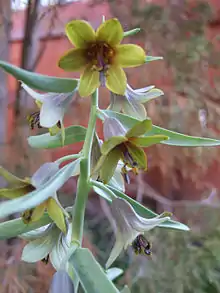Fritillaria sewerzowii
Fritillaria sewerzowii is a perennial herbaceous bulbous plant, distributed in alpine areas of central Asia. It is a species in the genus Fritillaria, in the family Liliaceae. It is placed in the subgenus Korolkowia.
| Fritillaria sewerzowii | |
|---|---|
 | |
| Scientific classification | |
| Kingdom: | |
| (unranked): | |
| (unranked): | Monocots |
| Order: | |
| Family: | |
| Genus: | |
| Subgenus: | Korolkowia |
| Species: | F. sewerzowii |
| Binomial name | |
| Fritillaria sewerzowii | |
| Synonyms[4][5][2] | |
| |
Description
F. sewerzowii reaches a height of between 20–50 cm. The egg-shaped bulb is about 5 cm in diameter. The leaves are fleshy and broadly oval at the base of the plant stem and are up to 15 cm in length and evenly distributed up the stem. The plant produces four to ten purple-brown star shaped individual flowers, 3 cm in length, arising from the leaf axes in the upper stem. F. sewerzowii blooms in early March.[6]
Taxonomy
First described by Regel in 1868,[1] Baker (1874), who divided Fritillaria into subgenera, placed F. sewerzowii in subgenus Korolkowia as its sole species.[7] Although some authors have treated Korolkowia as a separate genus,[8] molecular phylogenetics has shown that it is embedded within Fritillaria.[9][10]
Distribution and habitat
F. sewerzowii is found in scrub on rocky slopes or lightly wooded areas of Kyrgyzstan and Uzbekistan at 1000–3000 metres altitude.[6]
References
Bibliography
- Baker, J. G. (1874). "Revision of the Genera and Species of Tulipeae". Botanical Journal of the Linnean Society. xiv (76). F. sewerzowii p. 267. doi:10.1111/j.1095-8339.1874.tb00314.x.CS1 maint: ref=harv (link)
- Day, Peter D.; Berger, Madeleine; Hill, Laurence; Fay, Michael F.; Leitch, Andrew R.; Leitch, Ilia J.; Kelly, Laura J. (November 2014). "Evolutionary relationships in the medicinally important genus Fritillaria L. (Liliaceae)". Molecular Phylogenetics and Evolution. 80: 11–19. doi:10.1016/j.ympev.2014.07.024. PMID 25124097.
- Regel, Eduard August von (1868). "Enumeratio plantarum in regionibus cis- et transiliensibus a CL. seminovio anno 1857 collectarum: Liliaceae: Fritillaria sewerzowi Rgl, 443−444". Bulletin de la Société impériale des naturalistes de Moscou (in Latin). 41 (2): 378–459.CS1 maint: ref=harv (link)
- Rønsted, N.; Law, S.; Thornton, H.; Fay, M. F.; Chase, M. W. (2005). "Molecular phylogenetic evidence for the monophyly of Fritillaria and Lilium (Liliaceae; Liliales) and the infrageneric classification of Fritillaria". Molecular Phylogenetics and Evolution. 35 (3): 509–527. CiteSeerX 10.1.1.574.7908. doi:10.1016/j.ympev.2004.12.023. PMID 15878122.
- Turrill, William Bertram; Sealy, J. Robert (1980). "Studies in the Genus Fritillaria (Liliaceae)". Hooker's Icones Plantarum. 39: 1–2.CS1 maint: ref=harv (link)
- TPL (2013). "The Plant List 1.1: Fritillaria sewerzowii Regel". Royal Botanic Gardens, Kew and Missouri Botanical Garden. Retrieved 16 October 2017.CS1 maint: ref=harv (link)
- WCSP. "Fritillaria sewerzowiir Regel". World Checklist of Selected Plant Families (WCSP). Royal Botanic Gardens, Kew. Retrieved 11 October 2017.
- "Fritillaria sewerzowii Regel". International Plant Names Index. 2005. Retrieved 24 October 2017.
- "Fritillaria sewerzowii". Fritillaria species: A. Fritillaria Group, Alpine Garden Society. Retrieved 17 October 2017.
- Roskov Y.; Kunze T.; Orrell T.; Abucay L.; Paglinawan L.; Culham A.; Bailly N.; Kirk P.; Bourgoin T.; Baillargeon G.; Decock W.; De Wever A.; Didžiulis V., eds. (2014). "Fritillaria sewerzowii Regel". Species 2000 & ITIS Catalogue of Life: 2014 Annual Checklist. Naturalis, Leiden, the Netherlands: ITIS, Royal Botanic Gardens, Kew. Retrieved 23 October 2017.
- "Fritillaria sewerzowii - Regel". Plants for a Future. Retrieved 28 October 2017.
External links
| Wikispecies has information related to Fritillaria sewerzowii. |
| Wikimedia Commons has media related to Fritillaria sewerzowii. |